Three-Phase Probabilistic Power Flow Calculation Method Based on Improved Semi-Invariant Method for Low-Voltage Network
Abstract
1. Introduction
2. TP Power Flow Models for Components in LVN
2.1. The Mathematical Model of LVN Line
2.2. The Mathematical Model of LVN Load
2.3. The Mathematical Model of LVN Power Source
3. MC Simulation for Probabilistic Power Flow Calculation
3.1. Stochastic Fluctuation Model for Load Power
3.2. Stochastic Fluctuation Model for PV Output
3.3. Mathematical Significance of Probabilistic Power Flow
3.4. MC Simulation Technique
4. Three-Phase PPF Calculation Method for LVN Based on an Improved SIM
4.1. Linearization of Nonlinear Power Flow Equations
4.2. Improved SIM
- (1)
- Given that the random variable x is defined over the interval , which is equally divided into n points , the probability density at point is . Therefore, the cumulative distribution function (CDF) at can be calculated as:
- (2)
- The interval of the CDF is divided into n − 1 subintervals with spacing . On each subinterval , using the cumulative distribution y as the independent variable and the sample x as the dependent variable, a cubic interpolation is applied to establish the x-y relationship as:
- (3)
- For any given value of the cumulative distribution, must lie within a certain subinterval . By substituting into the x-y relationship, the corresponding sample can be obtained.
- (4)
- Based on the Cholesky decomposition method, the sampled samples are sorted to obtain the random sampling sequence.
4.3. GC Series Fitting
- (1)
- Conducting a pre-normality test (using the Anderson–Darling test with a significance level of α = 0.05) on all input random variables, including wind power, photovoltaic power, and loads;
- (2)
- Setting up large-scale Monte Carlo sampling as a benchmark.
5. Simulation Case Study and Analysis
5.1. Basic Data and Simulation Conditions
5.2. Simulation Results and Analysis
6. Conclusions
- (1)
- Drawing on the injection-type Newton method and based on the TP power measurements relative to the neutral point obtained from smart meters, the injected power is expressed in terms of injected current equations to establish TP power flow models for each component in the LVN.
- (2)
- For the stochastic fluctuation models of load power and PV output, conventional numerical methods and improved Latin hypercube sampling are employed, respectively. By utilizing linearized power flow equations, the PDF of the TP power flow in the LVN is calculated based on the improved SIM and GC series fitting.
- (3)
- Finally, simulation analysis of the proposed three-phase PPF method is conducted using an improved IEEE-13 node distribution system. The simulation results demonstrate that the proposed method can effectively perform three-phase PPF calculations for distribution network areas and accurately obtain the probabilistic distribution information of power flow in these areas.
Author Contributions
Funding
Data Availability Statement
Conflicts of Interest
References
- Li, Y.; Wan, C.; Cao, Z.; Song, Y. Data-Driven Nonparametric Probabilistic Optimal Power Flow: An Integrated Probabilistic Forecasting and Analysis Methodology. IEEE Trans. Power Syst. 2023, 38, 5820–5833. [Google Scholar] [CrossRef]
- Pareek, P.; Nguyen, H.D. Gaussian Process Learning-Based Probabilistic Optimal Power Flow. IEEE Trans. Power Syst. 2021, 36, 541–544. [Google Scholar] [CrossRef]
- Li, Y.; Wan, C.; Chen, D.; Song, Y. Nonparametric Probabilistic Optimal Power Flow. IEEE Trans. Power Syst. 2022, 37, 2758–2770. [Google Scholar] [CrossRef]
- Lin, X.; Shu, T.; Tang, J.; Ponci, F.; Monti, A.; Li, W. Application of Joint Raw Moments-Based Probabilistic Power Flow Analysis for Hybrid AC/VSC-MTDC Power Systems. IEEE Trans. Power Syst. 2022, 37, 1399–1412. [Google Scholar] [CrossRef]
- Kilinc, D.; Demir, A. Noise in Neuronal and Electronic Circuits: A General Modeling Framework and Non-Monte Carlo Simulation Techniques. IEEE Trans. Biomed. Circuits Syst. 2017, 11, 958–974. [Google Scholar] [CrossRef] [PubMed]
- Li, K.; Zhou, W.; Li, H.; Anastasio, M.A. A Hybrid Approach for Approximating the Ideal Observer for Joint Signal Detection and Estimation Tasks by Use of Supervised Learning and Markov-Chain Monte Carlo Methods. IEEE Trans. Med. Imaging 2022, 41, 1114–1124. [Google Scholar] [CrossRef]
- Jianbo, H.; Lei, Z.; Shukui, X. Safety analysis of wheel brake system based on STAMP/STPA and Monte Carlo simulation. J. Syst. Eng. Electron. 2018, 29, 1327–1339. [Google Scholar] [CrossRef]
- Krishna, A.B.; Abhyankar, A.R. Uniform Experimental Design-Based Nonparametric Quasi-Monte Carlo for Efficient Probabilistic Power Flow. IEEE Trans. Power Syst. 2023, 38, 2318–2332. [Google Scholar] [CrossRef]
- Jiang, Y.; Ren, Z.; Sun, Z.; Li, W.; Yang, X. A Stochastic Response Surface Method Based Probabilistic Energy Flow Analysis Method for Integrated Electricity and Gas Systems. IEEE Trans. Power Syst. 2022, 37, 2467–2470. [Google Scholar] [CrossRef]
- Garcia, G.C.; Vargas, R.; Melo, J.D.; Casella, I.R.S. Analysis of the Optimized Allocation of Wireless and PLC Data Concentrators in Extensive Low-Voltage Networks Considering the Increase in the Residential Electric Vehicles Charging. IEEE Access 2023, 11, 140774–140788. [Google Scholar] [CrossRef]
- Bian, J.; Wang, H.; Wang, L.; Li, G.; Wang, Z. Probabilistic optimal power flow of an AC/DC system with a multiport current flow controller. CSEE J. Power Energy Syst. 2021, 7, 744–752. [Google Scholar]
- Lin, C.; Bie, Z.; Chen, C. Operational Probabilistic Power Flow Analysis for Hybrid AC-DC Interconnected Power Systems With High Penetration of Offshore Wind Energy. IEEE Trans. Power Syst. 2023, 38, 3016–3028. [Google Scholar] [CrossRef]
- Li, Y.; Xu, Y.; Gu, W.; Lu, S.; Mili, L. Global Sensitivity Analysis for Rare Events in Probabilistic Power Flow Using Subset Simulation. IEEE Trans. Power Syst. 2025, 40, 1969–1972. [Google Scholar] [CrossRef]
- Lin, C.; Bie, Z.; Pan, C.; Liu, S. Fast Cumulant Method for Probabilistic Power Flow Considering the Nonlinear Relationship of Wind Power Generation. IEEE Trans. Power Syst. 2020, 35, 2537–2548. [Google Scholar] [CrossRef]
- Xu, Y.; Hu, Z.; Mili, L.; Korkali, M.; Chen, X. Probabilistic Power Flow Based on a Gaussian Process Emulator. IEEE Trans. Power Syst. 2020, 35, 3278–3281. [Google Scholar] [CrossRef]
- Vergara, P.P.; Giraldo, J.S.; Salazar, M.; Panda, N.K.; Nguyen, P.H. A Mixed-integer Linear Programming Model for Defining Customer Export Limit in PV-rich Low-voltage Distribution Networks. J. Mod. Power Syst. Clean Energy 2023, 11, 191–200. [Google Scholar] [CrossRef]
- Wang, G.; Li, Z.; Zhang, F.; Ju, P.; Wu, H.; Feng, C. Data-driven Probabilistic Static Security Assessment for Power System Operation Using High-order Moments. J. Mod. Power Syst. Clean Energy 2021, 9, 1233–1236. [Google Scholar] [CrossRef]
- Ali, K.H.; Aboushady, A.A.; Bradley, S.; Farrag, M.E.; Maksoud, S.A.A. An Industry Practice Guide for Underground Cable Fault-Finding in the Low Voltage Distribution Network. IEEE Access 2022, 10, 69472–69489. [Google Scholar] [CrossRef]
- Sun, W.; Zamani, M.; Hesamzadeh, M.R.; Zhang, H.-T. Data-Driven Probabilistic Optimal Power Flow With Nonparametric Bayesian Modeling and Inference. IEEE Trans. Smart Grid 2020, 11, 1077–1090. [Google Scholar] [CrossRef]
- Li, R.; Wong, P.; Wang, K.; Li, B.; Yuan, F. Power Quality Enhancement and Engineering Application with High Permeability Distributed Photovoltaic Access to Low-Voltage Distribution Networks in Australia. Prot. Control Mod. Power Syst. 2020, 5, 1–7. [Google Scholar] [CrossRef]
- Boglou, V.; Karlis, A. A Many-Objective Investigation on Electric Vehicles’ Integration Into Low-Voltage Energy Distribution Networks With Rooftop PVs and Distributed ESSs. IEEE Access 2024, 12, 132210–132235. [Google Scholar] [CrossRef]
- Zhang, X.; Li, C.; Li, D.; Jiang, S. Study on Operation Parameter Characteristics of Induction Filter Distribution Transformer in Low-Voltage Distribution Network. IEEE Access 2021, 9, 78764–78773. [Google Scholar] [CrossRef]
- Zichang, L.; Yadong, L.; Yingjie, Y.; Peng, W.; Xiuchen, J. An Identification Method for Asymmetric Faults With Line Breaks Based on Low-Voltage Side Data in Distribution Networks. IEEE Trans. Power Deliv. 2021, 36, 3629–3639. [Google Scholar] [CrossRef]
- McGarry, C.; Anderson, A.; Elders, I.; Galloway, S. A Scalable Geospatial Data-Driven Localization Approach for Modeling of Low Voltage Distribution Networks and Low Carbon Technology Impact Assessment. IEEE Access 2023, 11, 64567–64585. [Google Scholar] [CrossRef]
- Baviskar, A.; Das, K.; Koivisto, M.; Hansen, A.D. Multi-Voltage Level Active Distribution Network With Large Share of Weather-Dependent Generation. IEEE Trans. Power Syst. 2022, 37, 4874–4884. [Google Scholar] [CrossRef]
- Zhang, B.; Zhang, L.; Tang, W.; Li, G.; Wang, C. Optimal Planning of Hybrid AC/DC Low-Voltage Distribution Networks Considering DC Conversion of Three-Phase Four-Wire Low-Voltage AC Systems. J. Mod. Power Syst. Clean Energy 2024, 12, 141–153. [Google Scholar] [CrossRef]
- Liu, B.; Meng, K.; Dong, Z.Y.; Wong, P.K.C.; Ting, T. Unbalance Mitigation via Phase-Switching Device and Static Var Compensator in Low-Voltage Distribution Network. IEEE Trans. Power Syst. 2020, 35, 4856–4869. [Google Scholar] [CrossRef]
- Schlachter, H.; Geißendörfer, S.; von Maydell, K.; Agert, C. Load Recognition in Hardware-Based Low Voltage Distribution Grids Using Convolutional Neural Networks. IEEE Trans. Smart Grid 2024, 15, 1042–1051. [Google Scholar] [CrossRef]
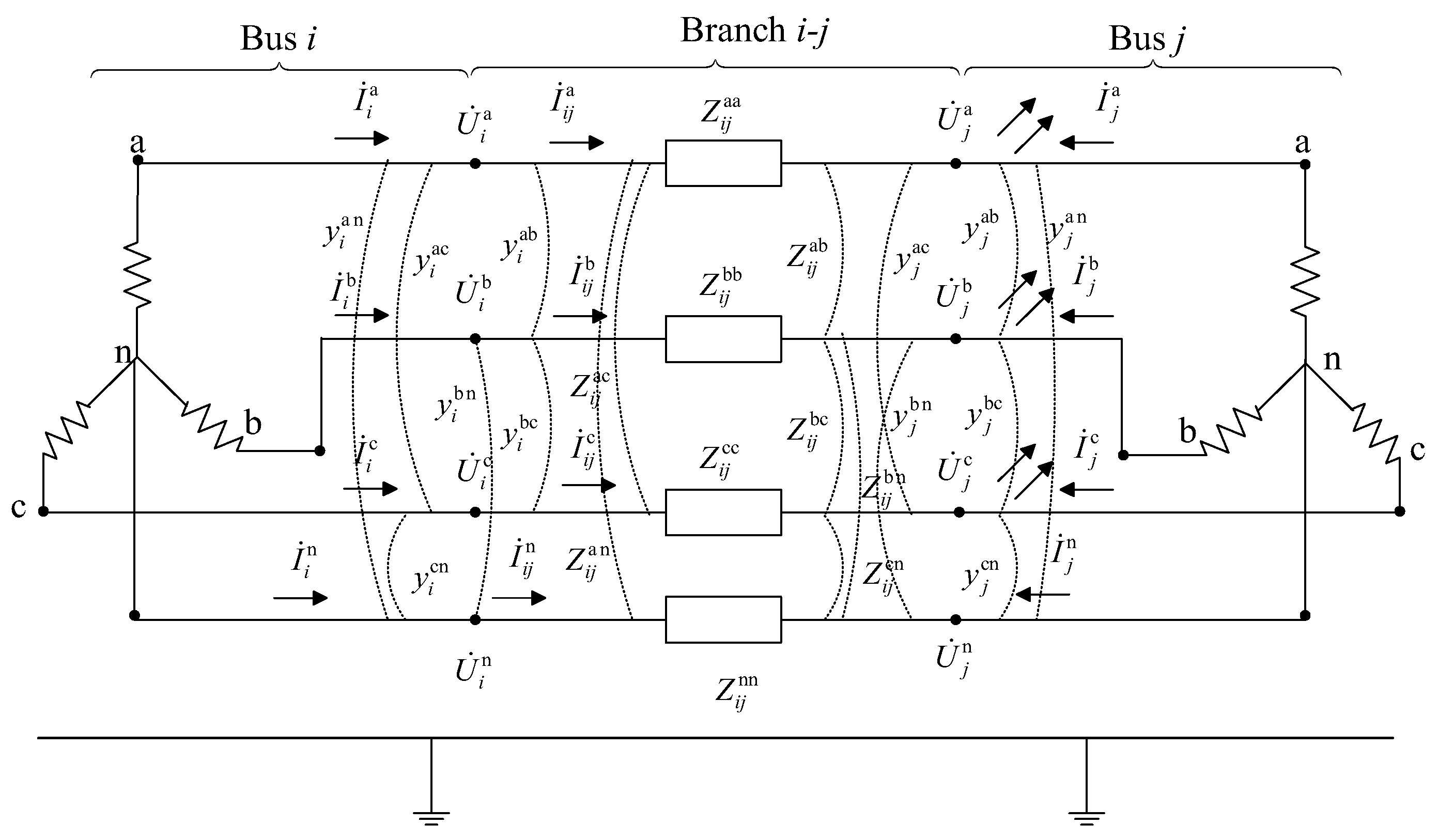
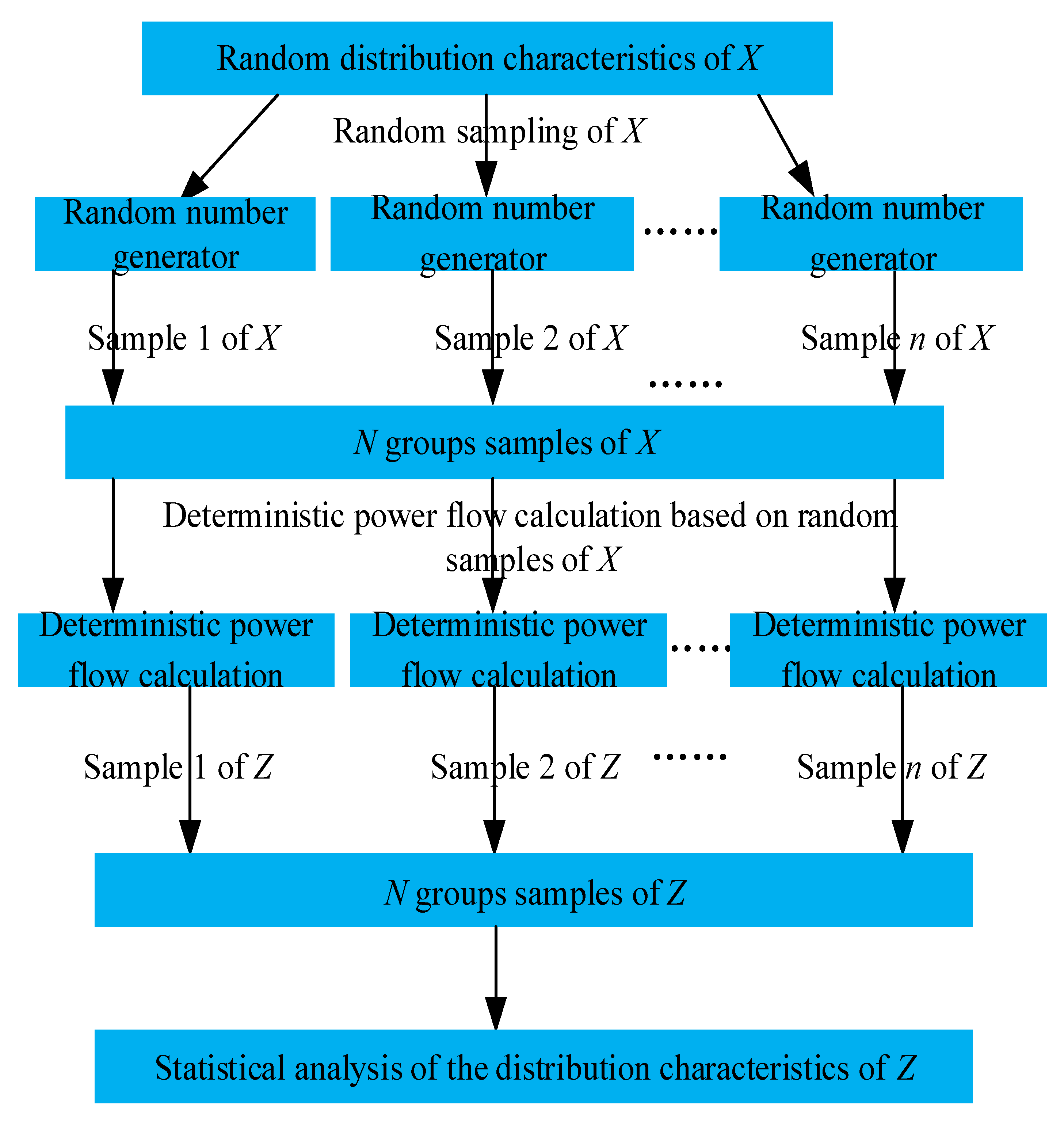
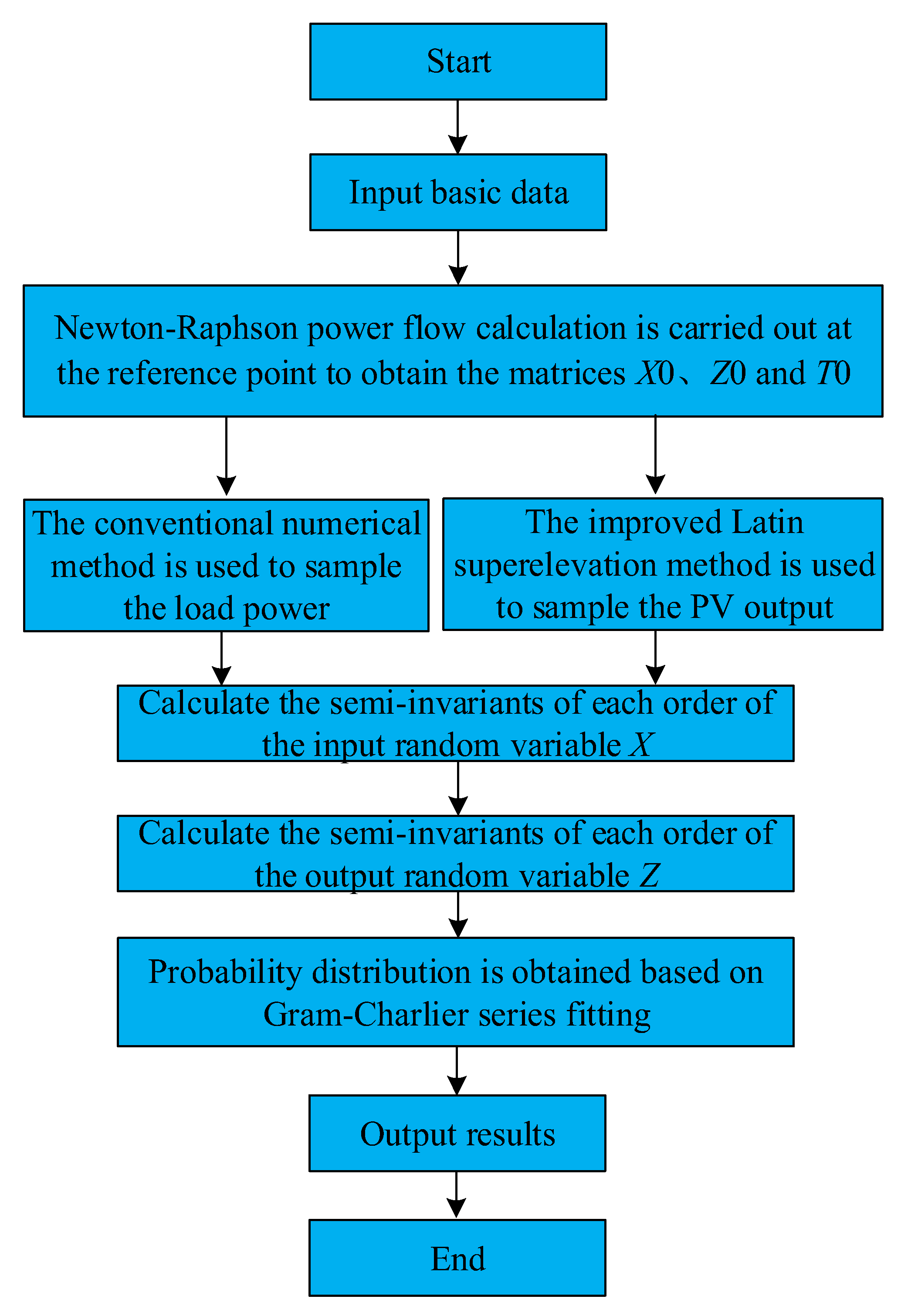
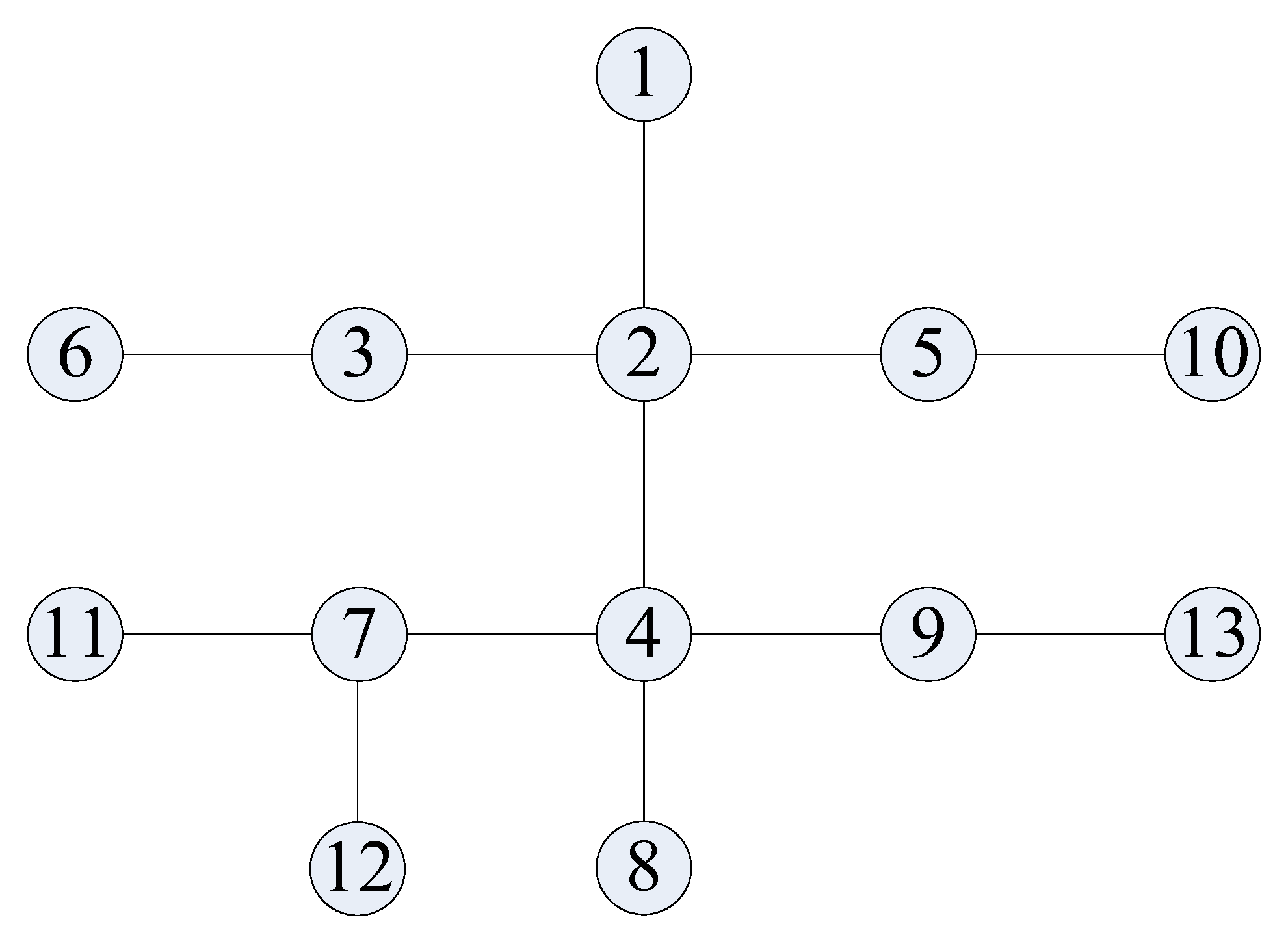
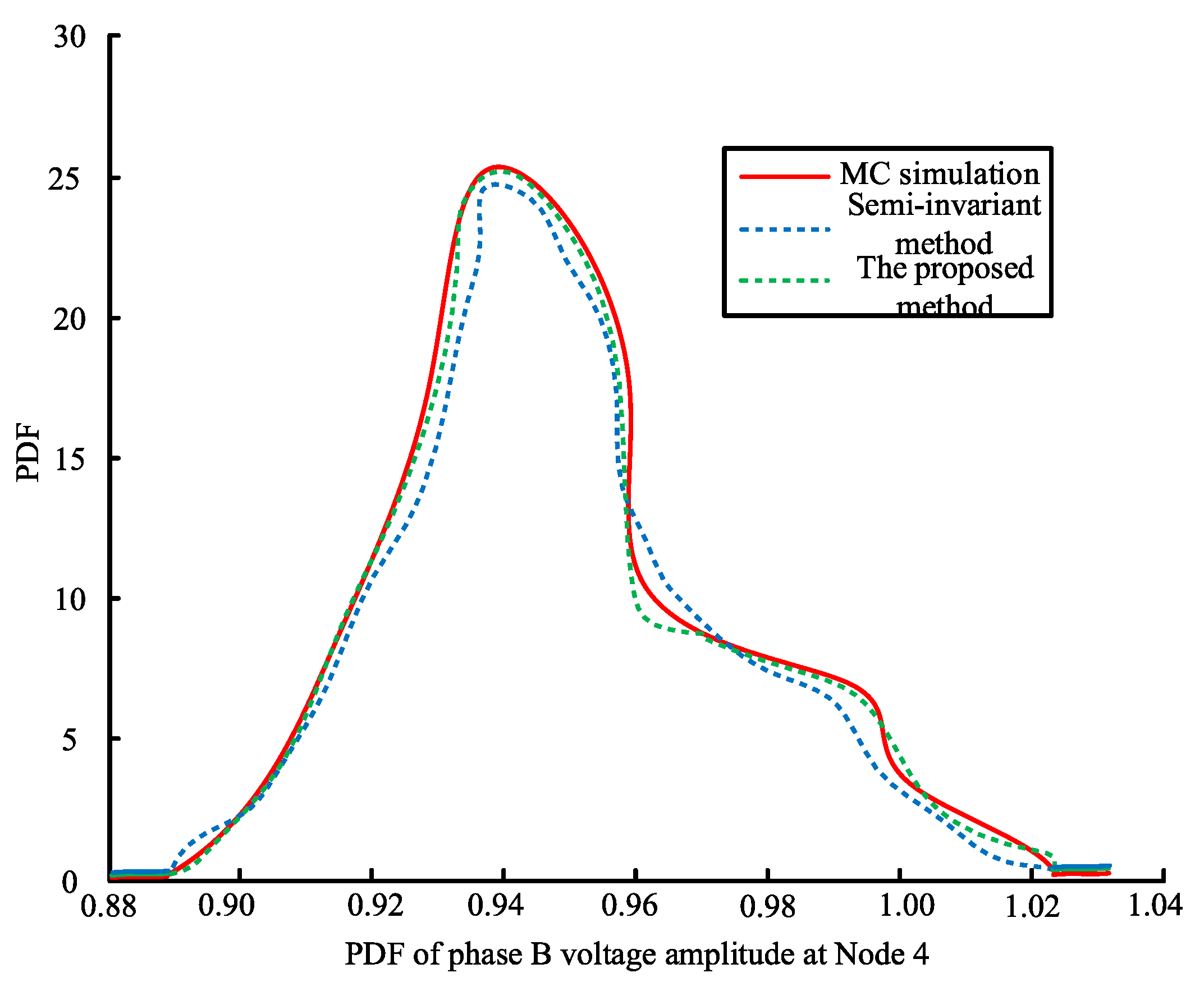
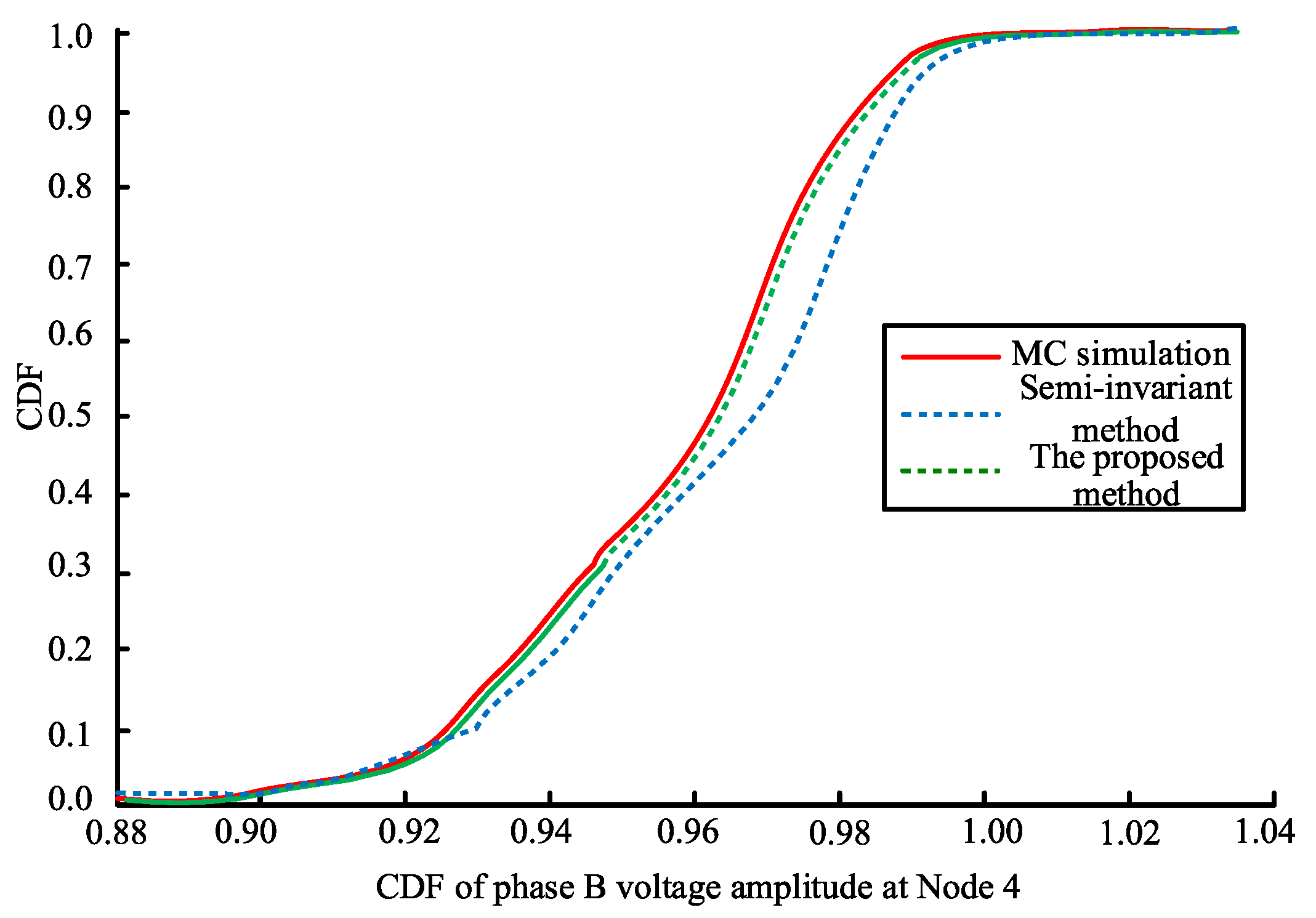
| Node | MC Simulation 107 Times | SIM | Error (%) | The Proposed Method | Error (%) | ||||||
|---|---|---|---|---|---|---|---|---|---|---|---|
| Mean | SD (10−2) | Mean (10−1) | SD (10−3) | Mean | SD | Mean (10−1) | SD (10−2) | Mean | SD | ||
| 4 | A | 0.9125 | 0.6035 | 9.1251 | 6.03505 | 0.0012 | 0.0008 | 9.12508 | 6.03503 | 0.0009 | 0.0005 |
| B | 0.9402 | 0.7323 | 9.4022 | 7.32311 | 0.0023 | 0.0015 | 9.40213 | 7.32309 | 0.0014 | 0.0012 | |
| C | 0.8751 | 1.0201 | 8.7511 | 10.2008 | 0.0009 | −0.0011 | 8.75104 | 10.2009 | 0.0005 | −0.0009 | |
| 6 | A | 0.9545 | 0.6217 | 9.5452 | 6.21706 | 0.0021 | 0.0009 | 9.54514 | 6.21704 | 0.0015 | 0.0006 |
| B | 0.9601 | 0.5364 | 9.6012 | 5.36406 | 0.0017 | 0.0012 | 9.60112 | 5.36404 | 0.0012 | 0.0008 | |
| C | 0.9351 | 0.3574 | 9.3512 | 3.57405 | 0.0019 | 0.0013 | 9.35112 | 3.57403 | 0.0013 | 0.0007 | |
| 13 | A | 0.9080 | 0.0983 | 9.0803 | 0.98302 | 0.0029 | 0.0023 | 9.08016 | 0.98302 | 0.0018 | 0.0021 |
| B | 0.9393 | 0.6354 | 9.3931 | 6.35396 | 0.0011 | −0.0007 | 9.39306 | 6.35397 | 0.0007 | −0.0005 | |
| C | 0.8706 | 0.4783 | 8.7061 | 4.78307 | 0.0013 | 0.0015 | 8.70608 | 4.78305 | 0.0009 | 0.0011 | |
| Node | MC Simulation 107 Times | SIM | Error (%) | The Proposed Method | Error (%) | ||||||
|---|---|---|---|---|---|---|---|---|---|---|---|
| Mean | SD | Mean (10−1) | SD (10−2) | Mean | SD | Mean (10−1) | SD (10−2) | Mean | SD | ||
| 4 | A | 0.3920 | 0.0387 | 3.9215 | 3.8710 | 0.0371 | 0.0239 | 3.9211 | 3.8708 | 0.0279 | 0.0201 |
| B | 0.4170 | 0.0415 | 4.2722 | 4.1513 | 0.0524 | 0.0311 | 4.1714 | 4.1510 | 0.0328 | 0.0244 | |
| C | 0.4422 | 0.0441 | 4.4231 | 4.4110 | 0.0239 | 0.0225 | 4.4228 | 4.4108 | 0.0172 | 0.0187 | |
| 6 | A | 0 | 0 | 0 | 0 | 0 | 0 | 0 | 0 | 0 | 0 |
| B | 0.2302 | 0.0230 | 2.3028 | 2.2994 | 0.0337 | −0.0253 | 2.3026 | 2.2996 | 0.0285 | −0.0173 | |
| C | 0 | 0 | 0 | 0 | 0 | 0 | 0 | 0 | 0 | 0 | |
| 13 | A | 0.4860 | 0.0482 | 4.8616 | 4.8191 | 0.0329 | −0.0195 | 4.8612 | 4.8192 | 0.0249 | −0.0162 |
| B | 0.0682 | 0.0065 | 0.6822 | 0.6502 | 0.0248 | 0.0327 | 0.6821 | 0.6502 | 0.0147 | 0.0277 | |
| C | 0.2899 | 0.0290 | 2.9002 | 2.9013 | 0.0441 | 0.0531 | 2.9000 | 2.9010 | 0.0338 | 0.0351 | |
| Method | Calculation Time (s) | Convergence Times |
|---|---|---|
| Traditional SIM | 32 | - |
| MC | 2157 | 128 |
| Quasi-MC | 1217 | 117 |
| The proposed method | 54 | 27 |
Disclaimer/Publisher’s Note: The statements, opinions and data contained in all publications are solely those of the individual author(s) and contributor(s) and not of MDPI and/or the editor(s). MDPI and/or the editor(s) disclaim responsibility for any injury to people or property resulting from any ideas, methods, instructions or products referred to in the content. |
© 2025 by the authors. Licensee MDPI, Basel, Switzerland. This article is an open access article distributed under the terms and conditions of the Creative Commons Attribution (CC BY) license (https://creativecommons.org/licenses/by/4.0/).
Share and Cite
Liu, K.; Wang, X.; Guo, H.; Zhang, W.; Liu, Y.; Zhou, C.; Zou, H. Three-Phase Probabilistic Power Flow Calculation Method Based on Improved Semi-Invariant Method for Low-Voltage Network. Processes 2025, 13, 2710. https://doi.org/10.3390/pr13092710
Liu K, Wang X, Guo H, Zhang W, Liu Y, Zhou C, Zou H. Three-Phase Probabilistic Power Flow Calculation Method Based on Improved Semi-Invariant Method for Low-Voltage Network. Processes. 2025; 13(9):2710. https://doi.org/10.3390/pr13092710
Chicago/Turabian StyleLiu, Ke, Xuebin Wang, Han Guo, Wenqian Zhang, Yutong Liu, Cong Zhou, and Hongbo Zou. 2025. "Three-Phase Probabilistic Power Flow Calculation Method Based on Improved Semi-Invariant Method for Low-Voltage Network" Processes 13, no. 9: 2710. https://doi.org/10.3390/pr13092710
APA StyleLiu, K., Wang, X., Guo, H., Zhang, W., Liu, Y., Zhou, C., & Zou, H. (2025). Three-Phase Probabilistic Power Flow Calculation Method Based on Improved Semi-Invariant Method for Low-Voltage Network. Processes, 13(9), 2710. https://doi.org/10.3390/pr13092710





